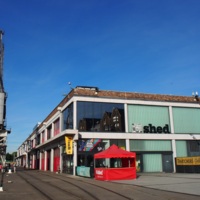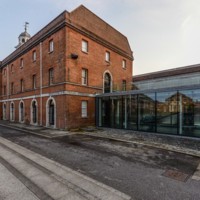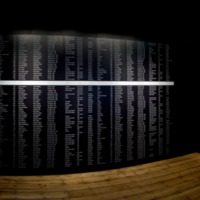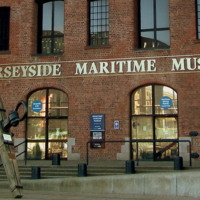
M Shed
M Shed opened in 2011 and is housed in a warehouse on Bristol’s dockside, a clear and tangible link to the history it interprets. The free-to-enter museum focuses on social history, exploring the development of Bristol as a city through people, places and daily life. It is a popular site, attaining over half a million visitors per year since 2013.
Through this local viewpoint, the museum explores Bristol’s involvement with the transatlantic slave trade and the abolition movement in its ‘Bristol People’ gallery which aims to ‘explore the activities past and present that make Bristol what it is.’ Voices from all factions of the slavery debate feature in the display, with proslavery, the enslaved, particularly those who fought for emancipation, and abolitionists all interpreted within dedicated cases. Each case contains a mix of objects, archive materials and text panels to tell the story. Quotations from key figures also bring to life the voices of those who were personally involved: for example, John Pinney, a plantation owner and sugar agent; Hannah More, a writer and Abolition campaigner; John Kimber, a slave ship captain accused (and acquitted) of murder; Silas Told, an ordinary sailor on slaving voyages. These Bristolian voices give different perspectives on how those involved in the trade saw it at the time. Quotations printed around the gallery also provide the views of today’s visitors to the trade. The exhibition also has sections about the legacies of the slave trade within Bristol, particularly in relation to the representation of African or Afro-Caribbean communities in popular culture, the presence of racism in the city, and the legacies of prominent slave owners in some of Bristol's public institutions.
The theme of antislavery also features as the starting point for a display on public protest movements. One case focusses on Thomas Clarkson’s visit to Bristol to collect information against the trade, another on the campaign to abstain from slave-produced sugar in the 18th century and the Bristol bus boycott against racist employment practices in the 20th century. This display then goes on to look at other popular campaigns and protest movements including women’s suffrage, riots, strikes and the Occupy movement. This perspective, situating the abolition campaign as the beginning of a British tradition of society campaigning, is a unique one across UK museums.
In the Bristol Life gallery, the stories of two Black Bristolians look at the new life for the runaway enslaved man, Henry Parker, and the Windrush generation Princess Campbell.

National Museum of the Royal Navy
The National Museum of the Royal Navy is located in Portsmouth’s Historic Dockyard. Its aim is, ‘to make accessible to all the story of the Royal Navy and its people from earliest times to the present.’ The museum, housed in a former naval storehouse, receives almost one million visitors per year.
Through five galleries, the museum charts the development of the Royal Navy and the experiences of the people who served in it. In the ‘Sailing Navy’ gallery, visitors can find out about the initial professionalisation of the navy during the eighteenth century. There are exhibits which discuss rations, health, hand-to-hand combat and available honours.
In this gallery, there is also a section of the display which discusses the other roles played by the Royal Navy, in addition to participation in conflict. The most striking exhibit in this section is a diorama model which depicts the use of the Royal Navy in the suppression of the slave trade, after the abolition of 1807. A little-known story in the British antislavery narrative, the model is accompanied by interpretive text which provides some context about the transatlantic slave trade and the campaign to abolish it. In addition, it also goes some way to outlining the prolonged involvement of Britain in eliminating other European slave trading in the years following 1807. While there are no artefacts used in narrating this story, the diorama itself provides a visualisation of the practice of suppression.

Museum of London Docklands
The Museum of London Docklands houses the Port and River collections of the Museum of London. The aim of these museums is to showcase the growth and development of London, from the Roman era through to the present day. In a period of expansion for the Museum of London, the Museum of London Docklands was opened in 2003 in a Grade I listed warehouse on West India Quay, the historic trading heart of London.
Due to its location in a warehouse which would very likely have stored sugar, and other slave-produced items, the history of the transatlantic slave trade and its impact on London fits well within this space. ‘London, Sugar and Slavery’ was originally produced in 2007 as part of the bicentenary commemorations but has since become a permanent part of the museum. The displays have a local focus, supported through a wide range of objects, and consider the impact of the slave trade on London historically and today.
On entering the gallery visitors are met with a list of ships that traded slaves from the West India Quay- placing them right there in the story. Next there are discussions of the economics of slavery, and indications of how the money made from it changed the city of London forever. The exhibition also includes discussions of resistance, and abolition- centring the movement on the mass movement in the wider population with a case entitled ‘Abolition on the Streets.’ To bring the display up to date there is a discussion of representations of black people in popular culture, with objects including children’s books, film memorabilia, toys and prints, in line with a further piece on racism in London.

International Slavery Museum
The International Slavery Museum (ISM) is the first museum in the world to focus specifically on slavery, both historical and modern. Managed by National Musuems Liverpool, it opened to great acclaim in 2007 and has since welcomed over 3.5million visitors. Through its displays and wide-ranging events programme, the ISM aims to tackle ignorance and misunderstanding in today’s society by exploring the lasting impact of the transatlantic slave trade around the world. On entering the ISM, visitors immediately arrive in a space designed to provoke thoughts and discussion- the walls are etched with powerful quotations from historical figures and contemporary activists, many from the African diaspora. There is a display of West African culture, designed to showcase the breadth and depth of African civilisation before the devastation caused by the transatlantic slave trade, which includes examples of textiles, musical instruments and other ethnographic material. The display then goes on to look at the trade itself; the logistics, the processes and who benefitted on one hand, whilst also exploring the experience of the enslaved through multisensory interpretive techniques, including an emotive film of what the Middle Passage may have been like. All of these displays are supported by the rich, local archival collections, drawing on Liverpool’s own history as a prosperous, slave-trading port. Moving forward along a chronological timeline, the exhibition then covers abolition, significantly beginning with the acts of resistance from the enslaved themselves, through to organised abolition movements and then discussing the continued fight for freedom through the post-emancipation then civil rights era, right into the twenty-first century. The lasting legacies of the trade are thoroughly examined, from racism and the under-development of African countries, to the spread of African culture and diverse nature of Liverpool’s communities. A unique feature of the ISM is its ‘Campaign Zone’, opened in 2010, which houses temporary exhibitions just off the main gallery space. These are frequently run in conjunction with campaign organisations and usually focus on aspects of modern slavery, highlighting to visitors that it is very much still a live issue and not one that has been relegated to history. Recent exhibitions in this space have included 'Broken Lives' organised with the Daalit Freedom Network and 'Afro Supa Hero' with artist Jon Daniels.